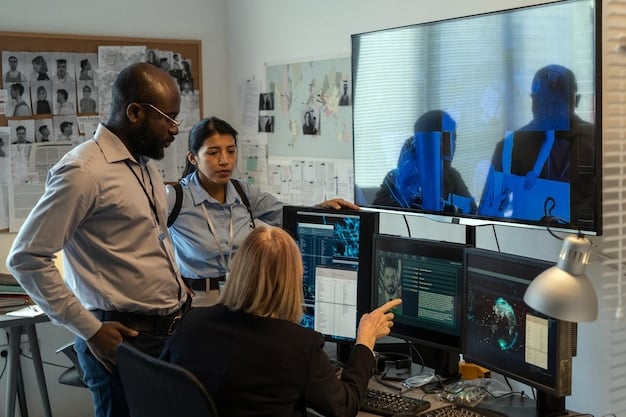US Cyberattack Preparedness: Are We Ready for Critical Infrastructure Threats?

The United States faces a significant challenge in preparing for large-scale cyberattacks on critical infrastructure, necessitating robust collaborative defense strategies, technological advancements, and comprehensive policy frameworks to enhance resilience against evolving threats.
The digital age has ushered in unprecedented connectivity and innovation, but with it comes a menacing shadow: the escalating threat of cyberattacks. A question of paramount importance reverberates across government agencies, corporations, and communities alike: Is the US prepared for a large-scale cyberattack on critical infrastructure? This isn’t merely a theoretical exercise; it’s a tangible concern shaping national security strategies, economic stability, and public safety in an increasingly interconnected world.
Understanding the Threat Landscape
The contemporary cyber threat landscape is a complex tapestry woven with state-sponsored actors, cybercriminal organizations, and even extremist groups, each leveraging sophisticated tools and techniques. Critical infrastructure, encompassing sectors like energy, water, transportation, and healthcare, represents the very backbone of modern society. Disrupting these systems can have cascading effects, leading to widespread chaos and significant economic and human cost.
The sophistication of attacks has grown exponentially. From distributed denial-of-service (DDoS) attacks designed to overwhelm systems, to ransomware that encrypts data and holds it hostage, and supply chain attacks that infiltrate systems through trusted third parties, the methods are diverse and continually evolving. Adversaries are not static; they adapt, innovate, and exploit vulnerabilities at an alarming rate, often operating with impunity from safe havens.
Key Adversaries and Motivations
Several types of actors pose significant threats. Nation-states, driven by geopolitical ambitions or economic espionage, often possess the most advanced capabilities and resources. Their objectives can range from intelligence gathering and intellectual property theft to direct sabotage of infrastructure to gain a tactical advantage in a conflict. Criminal enterprises, on the other hand, are primarily motivated by financial gain, employing ransomware, data exfiltration, and extortion tactics.
- Nation-State Actors: Highly resourced, state-sponsored entities aiming for espionage, sabotage, or geopolitical leverage.
- Cybercriminal Syndicates: Organized groups focused on financial profit through ransomware, data theft, and fraud.
- Hacktivists: Groups using cyber means to promote political or social agendas, often involving data breaches or website defacements.
Understanding the “why” behind these attacks is as crucial as understanding the “how.” For nation-states, the aim might be to disrupt electoral processes, paralyze financial markets, or disable defense capabilities. For criminals, it’s a direct path to ill-gotten gains. This diverse set of motivations necessitates a multi-faceted defense strategy that addresses both the technical and human elements of cybersecurity.
Vulnerabilities in Critical Infrastructure
Critical infrastructure often presents a unique set of vulnerabilities. Many of these systems were designed decades ago, pre-dating modern cybersecurity considerations, and are now integrated into complex, interconnected digital networks. This legacy technology, often referred to as operational technology (OT) or industrial control systems (ICS), can be difficult to patch, monitor, and secure without disrupting essential services. Furthermore, the convergence of IT and OT networks, while offering efficiency, also expands the attack surface, creating new pathways for adversaries to exploit.
The human factor remains a significant vulnerability. Phishing attacks, social engineering, and insider threats can bypass even the most robust technological defenses. A single click on a malicious link can lead to catastrophic data breaches or system compromise. Moreover, the sheer scale and complexity of critical infrastructure mean that no single entity can secure it alone; effective defense requires extensive collaboration and information sharing among public and private sectors.
While significant strides have been made in protecting critical infrastructure, the ongoing evolution of threat actors and their methodologies ensures that preparedness is a perpetual journey, not a destination. The challenge lies in staying one step ahead, anticipating new attack vectors, and continuously bolstering defenses.
Current State of US Cyber Preparedness
The United States has made significant investments and strategic shifts to enhance its cybersecurity posture, particularly concerning critical infrastructure. Recognizing the existential threat, various government agencies and private sector entities have collaborated to implement frameworks, share intelligence, and develop response protocols. However, the path to comprehensive readiness is fraught with challenges, revealing both areas of strength and persistent gaps.
At the federal level, agencies like the Cybersecurity and Infrastructure Security Agency (CISA), the National Institute of Standards and Technology (NIST), and the Department of Homeland Security (DHS) play pivotal roles. CISA, for instance, focuses on defending civilian government networks and works with critical infrastructure operators to enhance their security postures. NIST provides widely adopted cybersecurity frameworks that offer guidelines for managing cyber risks.

Government Initiatives and Agencies
Numerous initiatives underscore the US government’s commitment. The Biden Administration’s Executive Order on Improving the Nation’s Cybersecurity, issued in May 2021, mandated significant changes across federal agencies, emphasizing information sharing, supply chain security, and incident response planning. Furthermore, sector-specific agencies often lead efforts within their domains, such as the Department of Energy for the electric grid or the Transportation Security Administration for pipelines.
- CISA: Leads national efforts to understand, manage, and reduce risk to cyber and physical infrastructure.
- NIST Cybersecurity Framework: Provides a voluntary framework for organizations to manage and reduce cybersecurity risks.
- Sector-Specific Agencies: Agencies focusing on cybersecurity within their respective critical infrastructure sectors (e.g., DOE for energy).
These efforts are geared towards creating a more resilient cyber ecosystem. Information sharing platforms and threat intelligence centers aim to disseminate timely warnings and best practices. There’s also an increasing emphasis on proactive threat hunting and offensive cyber capabilities to deter adversaries and disrupt their operations before they can cause damage.
Public-Private Partnerships and Information Sharing
Given that the majority of critical infrastructure is privately owned and operated, effective cybersecurity necessitates robust public-private partnerships. Programs like Information Sharing and Analysis Centers (ISACs) facilitate the exchange of threat intelligence and best practices within specific sectors. These partnerships are crucial for building a collective defense against sophisticated threats that often target multiple entities simultaneously.
However, challenges persist. Barriers to effective information sharing include concerns over proprietary data, liability issues, and a lack of trust between some private entities and government agencies. While these partnerships have matured, there’s a continuous need to foster greater collaboration and ensure that critical information flows seamlessly in both directions, especially during times of crisis. The speed at which threat intelligence is shared can often determine the success or failure of defending against evolving attacks.
Despite these strides, the sheer scale and dynamic nature of the cyber threat mean that preparedness is an ongoing challenge. The US is building a multi-layered defense, but the question remains whether these measures are sufficient to withstand a truly large-scale, coordinated attack that aims to cripple multiple critical sectors simultaneously.
Weaknesses and Gaps in Preparedness
Despite the concerted efforts to bolster the US’s cybersecurity defenses, significant weaknesses and gaps persist, raising concerns about the nation’s readiness to withstand a large-scale cyberattack on its critical infrastructure. These vulnerabilities span technological, policy, and human factors, presenting a complex challenge that requires continuous attention and robust solutions.
Aging Infrastructure and Legacy Systems
A primary concern is the prevalence of aging infrastructure and legacy systems, particularly within operational technology (OT) environments like power grids, water treatment plants, and transportation networks. Many of these systems were designed decades ago, long before pervasive digital connectivity, and lack modern cybersecurity controls. Integrating them into modern IT networks, while often necessary for efficiency, inadvertently creates new attack vectors that skilled adversaries can exploit.
Updating or replacing these systems is incredibly complex, costly, and often involves significant downtime, making it a slow and arduous process. Patching vulnerabilities can disrupt essential services, leading many operators to prioritize uptime over immediate security fixes. This creates a fertile ground for attackers who can leverage known vulnerabilities in unsupported software or hardware.
Skills Gap and Workforce Shortages
The cybersecurity industry faces a severe talent shortage, exacerbating vulnerabilities across all sectors, including critical infrastructure. There aren’t enough skilled professionals to fill the demand for roles such as security analysts, incident responders, and industrial control system (ICS) security specialists. This deficit means many organizations, especially smaller utilities or those with limited budgets, struggle to implement and maintain effective security programs.
- Lack of Qualified Professionals: A significant shortage of cybersecurity experts, particularly in specialized areas like OT/ICS security.
- Retention Challenges: High demand allows skilled personnel to move frequently, making it difficult for organizations to build long-term expertise.
- Training Deficiencies: Insufficient training programs that bridge the gap between traditional IT and the unique challenges of OT environments.
Even when personnel are available, their training often lags behind the rapidly evolving threat landscape. The unique intricacies of securing industrial control systems require specialized knowledge that differs significantly from traditional IT cybersecurity, creating an even narrower talent pool.
Coordination and Information Sharing Challenges
While public-private partnerships are crucial, effective coordination and timely information sharing remain persistent challenges. The sheer diversity of critical infrastructure players—from large corporations to small municipal utilities—means that security maturity levels vary wildly. Smaller entities often lack the resources or expertise to detect and respond to sophisticated attacks, making them potential weak links in the overall defense.
Information sharing is often hampered by legal liabilities, intellectual property concerns, and a general reluctance to reveal vulnerabilities that could damage reputations or trigger regulatory scrutiny. This creates silos of information, preventing a holistic understanding of the threat landscape and hindering rapid, coordinated responses when incidents occur. Overcoming these barriers requires persistent effort, trust-building, and clear policy incentives.
Addressing these weaknesses is not merely a technical problem; it requires a systemic approach involving policy reforms, workforce development initiatives, and sustained investment to build truly resilient critical infrastructure against the backdrop of an ever-present and evolving cyber threat.
Enhancing Resilience: Strategies and Solutions
Building true resilience against large-scale cyberattacks on critical infrastructure goes beyond mere prevention; it involves developing the capacity to absorb, adapt to, and recover quickly from disruptive events. This requires a multi-pronged approach that integrates technological advancements, policy reforms, and a culture of cybersecurity awareness and collaboration.
Investing in Modernization and Secure-by-Design Principles
One of the most critical strategies is the accelerated modernization of aging infrastructure. This includes replacing vulnerable legacy systems with modern, cyber-secure alternatives. However, simply upgrading is not enough; new systems must incorporate “secure-by-design” principles from their inception. This means security is baked into every layer of development, rather than being an afterthought. This proactive approach significantly reduces the attack surface and minimizes inherent vulnerabilities.
Emphasis should also be placed on network segmentation within critical infrastructure environments. Isolating operational technology (OT) from information technology (IT) networks, and segmenting critical systems from less critical ones, can contain breaches and prevent them from cascading across an entire organization or sector. Micro-segmentation and Zero Trust architectures are becoming increasingly vital for controlling access and limiting the lateral movement of adversaries within networks.
Workforce Development and Training
Addressing the cybersecurity skills gap is paramount. This requires a national effort to expand and improve cybersecurity education and training programs, from K-12 initiatives to university degrees and vocational certifications. Special emphasis must be placed on developing expertise in ICS/OT security, which demands a unique blend of IT knowledge, engineering principles, and an understanding of industrial processes.

- Educational Pipelines: Expanding undergraduate and graduate programs in cybersecurity, especially with OT/ICS specializations.
- Hands-on Training: Creating realistic simulation environments for incident response and system recovery drills.
- Cross-Sector Collaboration: Encouraging partnerships between educational institutions, government agencies, and industry to tailor curricula to real-world needs.
Continuous training and professional development are also crucial for existing personnel to keep pace with evolving threats and technologies. Investing in certifications and creating pathways for career advancement can help retain talent within critical infrastructure sectors.
Strengthening Public-Private Information Sharing and Collaboration
True resilience hinges on seamless collaboration between government and private entities. This means enhancing existing information-sharing mechanisms, such as ISACs, and fostering greater trust. Policies and incentives that encourage the sharing of threat intelligence, best practices, and vulnerability information must be prioritized, potentially including legal protections for companies that report incidents.
Joint exercises and simulations involving both public and private sector actors are invaluable for testing response plans, identifying weaknesses, and building relationships before a real crisis hits. These exercises help refine communication channels, clarify roles and responsibilities, and improve the overall coordination of incident response efforts. The goal is to move towards a collective defense model where information sharing is standard practice, not an exception.
Ultimately, enhancing cyber resilience is a continuous journey that requires foresight, adaptability, and an unwavering commitment to protecting the foundational systems that underpin society. There is no silver bullet, but rather a combination of diligent planning, robust investment, and sustained collaboration.
The Role of AI and Advanced Technologies
Artificial intelligence (AI), machine learning (ML), and other advanced technologies are rapidly transforming the cybersecurity landscape, offering powerful new tools to both defenders and attackers. For the US to enhance its preparedness against large-scale cyberattacks on critical infrastructure, strategically leveraging these technologies is not just an advantage, but a necessity.
AI in Threat Detection and Response
AI and ML algorithms are revolutionizing threat detection by moving beyond signature-based methods to identify anomalous behaviors and novel attack patterns. In critical infrastructure environments, where traditional security tools can sometimes be disruptive, AI-powered solutions can continuously monitor network traffic, system logs, and user behavior to identify indicators of compromise with greater speed and accuracy than human analysts alone.
For instance, AI can analyze vast datasets to pinpoint subtle deviations from normal operational parameters in industrial control systems (ICS), potentially identifying an intrusion before it escalates into a major disruption. AI can also automate parts of the incident response process, such as triaging alerts, enriching data about threats, and even deploying initial containment measures, thereby reducing response times in high-stress situations. This allows human experts to focus on the most complex and strategic aspects of an attack.
Proactive Defense and Predictive Analytics
Beyond reaction, AI offers significant promise in proactive defense and predictive analytics. By analyzing historical attack data, threat intelligence, and vulnerability information, ML models can predict potential attack vectors, identify likely targets, and even forecast the types of attacks that adversaries might launch. This foresight allows critical infrastructure operators to prioritize defenses, patch vulnerabilities proactively, and allocate resources more efficiently.
AI can also be used to enhance vulnerability management by automatically scanning systems for weaknesses, prioritizing patches based on risk scores, and even simulating potential attack paths to identify critical points of failure. This moves cybersecurity from a reactive posture to a more predictive and preventive one, significantly bolstering resilience against sophisticated, evolving threats.
Challenges and Ethical Considerations
While the potential of AI is immense, its implementation in critical infrastructure cybersecurity is not without challenges. These include the need for high-quality, relevant data to train AI models effectively, the risk of “adversarial AI” where attackers manipulate AI systems, and the inherent complexity of integrating AI solutions into existing, often heterogeneous, operational environments.
Ethical considerations are also crucial. The increasing autonomy of AI in decision-making within critical systems raises questions about accountability, bias in algorithms, and the potential for unintended consequences. Ensuring transparency, control, and human oversight over AI-driven systems is paramount to building trust and preventing catastrophic errors. The strategic adoption of AI requires not just technological prowess but also robust governance frameworks and a clear understanding of its limitations and risks.
Ultimately, AI and advanced technologies are powerful force multipliers in the defense of critical infrastructure. Their effective integration, coupled with skilled human oversight, will be fundamental to the US’s ability to maintain a strong cyber defense in the face of increasingly sophisticated and automated threats.
Legal and Policy Frameworks
Robust legal and policy frameworks are the foundational pillars supporting a nation’s cybersecurity preparedness. In the United States, these frameworks aim to define roles, establish responsibilities, mandate security standards, and provide the authority necessary for deterrent and responsive actions against cyberattacks on critical infrastructure. However, the rapidly evolving nature of cyber threats often outpaces the legislative process, necessitating continuous adaptation and refinement.
Existing Legislation and Executive Orders
Numerous laws and executive orders form the current bedrock of US cybersecurity policy. The Federal Information Security Modernization Act (FISMA) mandates cybersecurity standards for federal agencies, setting a baseline for government security. Beyond this, sector-specific regulations exist, such as those implemented by the North American Electric Reliability Corporation (NERC) for the bulk electric power system through its Critical Infrastructure Protection (CIP) standards, which are legally enforceable.
Executive orders have played a crucial role in swiftly addressing emerging threats. The Biden Administration’s Executive Order 14028, “Improving the Nation’s Cybersecurity,” is a prime example, pushing for zero-trust architecture adoption, enhanced supply chain security, and better information sharing across federal agencies and with the private sector. These mandates set a higher bar for security practices and aim to harmonize approaches across various entities.
Challenges in Policy Implementation and Enforcement
Despite existing frameworks, challenges in policy implementation and enforcement persist. One major hurdle is the voluntary nature of many cybersecurity guidelines for private sector critical infrastructure, such as the NIST Cybersecurity Framework. While widely adopted, its voluntary status means that organizations can choose not to implement crucial safeguards, potentially leaving significant vulnerabilities.
Enforcement also varies, and a lack of consistent, robust penalties for non-compliance can diminish the incentive for some organizations to invest adequately in cybersecurity. Furthermore, the sheer breadth of critical infrastructure sectors, each with unique operational environments and regulatory bodies, often leads to a fragmented policy landscape, making a truly unified national approach difficult to achieve.
The speed of cyberattacks often outpaces the traditional legal process, making it difficult to legislate in real-time. This can result in policies that are reactive rather than proactive, or that become outdated quickly.
Future Policy Directions and International Cooperation
Future policy directions are likely to focus on making certain cybersecurity practices mandatory for critical infrastructure, particularly in high-risk sectors, and potentially offering incentives for robust implementations. There’s also a growing recognition of the need for stronger supply chain security regulations to prevent attacks originating from trusted third-party vendors.
International cooperation is another vital component. Cyberattacks often originate from beyond national borders, necessitating strong diplomatic and intelligence partnerships to share threat information, track adversaries, and coordinate responses. Developing international norms for responsible state behavior in cyberspace and deterring malicious activities through collective action are increasingly important. Bilateral and multilateral agreements aimed at joint cyber defense and information sharing are crucial for creating a truly global cyber deterrent.
Effective legal and policy frameworks must strike a balance between providing necessary security mandates and fostering innovation, all while adapting with agility to the constantly evolving cyber threat landscape. This dynamic interplay will define the nation’s legal cyber readiness for years to come.
Future Outlook and Recommendations
Assessing the US’s preparedness for a large-scale cyberattack on critical infrastructure reveals a complex picture: significant progress has been made, yet substantial vulnerabilities and evolving threats mean that preparedness is an ongoing, dynamic challenge. The future outlook demands a sustained, proactive, and collaborative approach to enhance national resilience.
Continuous Adaptation to Evolving Threats
The most critical aspect of future preparedness is the ability to continuously adapt. Cyber adversaries are not static; they innovate, adopt new technologies, and exploit novel vulnerabilities. Therefore, cybersecurity defenses must evolve at an equal or faster pace. This includes ongoing investment in research and development for next-generation security technologies, such as advanced AI for threat hunting and quantum-resistant cryptography.
Regular threat intelligence sharing and analysis, not just within sectors but across the entire critical infrastructure ecosystem, will be paramount. This allows defenders to understand emerging attack methodologies, identify common vulnerabilities, and develop collective countermeasures. Drills and simulations, which test response protocols under realistic scenarios, must become a routine feature of operational preparedness across all critical sectors.
Prioritizing Resilience Over Mere Prevention
While prevention remains essential, the focus must shift towards building inherent resilience. Accepting that some attacks will inevitably succeed, the goal becomes minimizing their impact and accelerating recovery. This involves implementing robust backup and recovery strategies, developing redundant systems, and investing in capabilities for rapid reconstitution of services. Cyber resilience means being able to absorb a shock, continue essential functions, and rapidly restore full capabilities.
Decentralization of certain critical systems and diversifying operational redundancies could also be considered to reduce single points of failure. This means designing systems that can operate independently or with reduced functionality even if parts of the network are compromised. The concept of “cyber-physical” resilience, where the interplay between digital and physical security is deeply understood, will also be vital.
Strengthening the Cybersecurity Ecosystem
A truly prepared nation relies on a robust cybersecurity ecosystem. This entails a holistic approach that includes continued investment in workforce development and training, ensuring a steady pipeline of skilled professionals for both private industry and government. It also requires fostering a culture of cybersecurity awareness throughout society, recognizing that every individual plays a role in collective defense.
Furthermore, policy initiatives must evolve to incentivize stronger security practices across all critical infrastructure owners and operators, perhaps moving towards more mandatory cybersecurity standards where appropriate, while also fostering an environment of innovation and collaboration. International partnerships will also become increasingly vital for sharing threat intelligence, coordinating responses, and establishing norms for responsible state behavior in cyberspace.
In conclusion, the US has come a long way in its cybersecurity preparedness, but the journey is far from over. A large-scale cyberattack on critical infrastructure remains a potent threat. Future success hinges on proactive adaptation, a prioritization of resilience, and a strengthened ecosystem where all stakeholders—government, private sector, and citizens—work in concert to defend the foundational elements of American society.
| Key Point | Brief Description |
|---|---|
| 🛡️ Evolving Threats | Cyber adversaries constantly adapt, demanding continuous evolution of defense strategies. |
| 🔗 Interconnected Vulnerabilities | Aging infrastructure and IT/OT convergence create numerous entry points for attacks. |
| 🤝 Public-Private Imperative | Effective defense hinges on strong collaboration and information sharing between government and private sectors. |
| 💡 Tech & Policy Adaptation | Leveraging AI and dynamic policy frameworks are critical for future resilience. |
Frequently Asked Questions (FAQ)
▼
Critical infrastructure refers to the essential systems and assets vital for a nation’s functioning, such as energy, water, transportation, and healthcare. These are targeted because their disruption can cause widespread economic damage, public safety hazards, and undermine national security, providing adversaries with significant leverage or achieving disruptive goals.
▼
Primary actors typically include state-sponsored groups, cybercriminal syndicates, and, less frequently, hacktivists or extremist organizations. Nation-states often seek espionage or strategic disruption, while criminal groups are primarily motivated by financial gain through tactics like ransomware. Their sophistication and resources vary significantly.
▼
The US government collaborates extensively with the private sector through initiatives like Information Sharing and Analysis Centers (ISACs), providing threat intelligence, cybersecurity frameworks (e.g., NIST), and offering guidance. Agencies like CISA work directly with critical infrastructure operators to enhance their defense capabilities and incident response readiness, acknowledging that most critical infrastructure is privately owned.
▼
Key challenges include securing aging legacy systems, addressing the significant cybersecurity workforce shortage, and overcoming barriers to effective information sharing between diverse stakeholders. The unique operational complexities of industrial control systems also pose distinct security hurdles compared to traditional IT environments, requiring specialized expertise and tools.
▼
AI and machine learning are increasingly used for advanced threat detection by identifying anomalous behaviors and novel attack patterns that human analysts might miss. They also assist in proactive defense through predictive analytics, automating parts of incident response, and enhancing vulnerability management, ultimately moving defenses from reactive to more preventive and adaptive stances.
Conclusion
The question of whether the US is fully prepared for a large-scale cyberattack on critical infrastructure does not yield a simple affirmative. While substantial progress has been made in developing frameworks, fostering partnerships, and deploying advanced technologies, the evolving nature of cyber threats, coupled with inherent vulnerabilities in legacy systems and workforce shortages, indicates that preparedness is a continuous journey. The nation is demonstrably more resilient than in the past, but the commitment to sustained investment, adaptive strategies, and strengthened collaboration across all sectors will ultimately determine its capacity to withstand and rapidly recover from future digital assaults.





